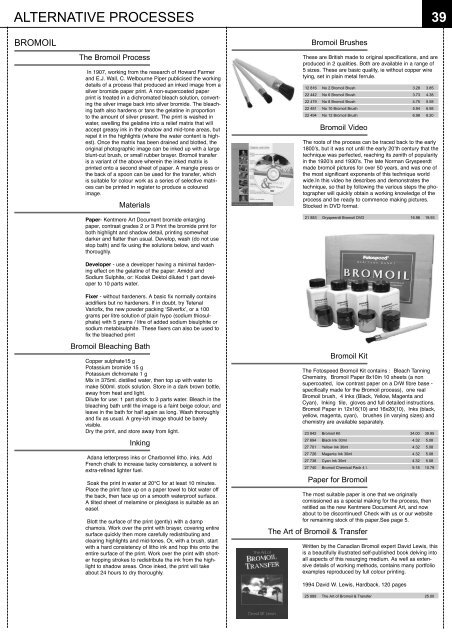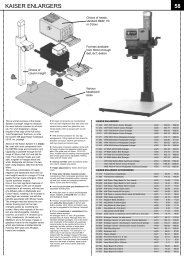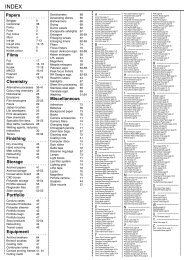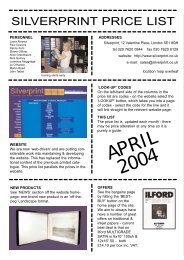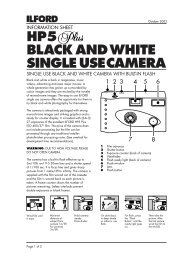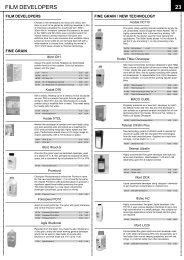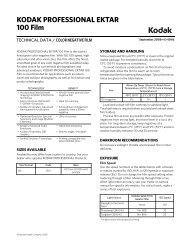36 EMULSION WORK - Silverprint
36 EMULSION WORK - Silverprint
36 EMULSION WORK - Silverprint
Create successful ePaper yourself
Turn your PDF publications into a flip-book with our unique Google optimized e-Paper software.
ALTERNATIVE PROCESSES<br />
BROMOIL<br />
The Bromoil Process<br />
In 1907, working from the research of Howard Farmer<br />
and E.J. Wall, C. Welbourne Piper publicised the working<br />
details of a process that produced an inked image from a<br />
silver bromide paper print. A non-supercoated paper<br />
print is treated in a dichromated bleach solution, converting<br />
the silver image back into silver bromide. The bleaching<br />
bath also hardens or tans the gelatine in proportion<br />
to the amount of silver present. The print is washed in<br />
water, swelling the gelatine into a relief matrix that will<br />
accept greasy ink in the shadow and mid-tone areas, but<br />
repel it in the highlights (where the water content is highest).<br />
Once the matrix has been drained and blotted, the<br />
original photographic image can be inked up with a large<br />
blunt-cut brush, or small rubber brayer. Bromoil transfer<br />
is a variant of the above wherein the inked matrix is<br />
printed onto a second sheet of paper. A mangle press or<br />
the back of a spoon can be used for the transfer, which<br />
is suitable for colour work as a series of selective matrices<br />
can be printed in register to produce a coloured<br />
image.<br />
Materials<br />
Paper- Kentmere Art Document bromide enlarging<br />
paper, contrast grades 2 or 3 Print the bromide print for<br />
both highlight and shadow detail, printing somewhat<br />
darker and flatter than usual. Develop, wash (do not use<br />
stop bath) and fix using the solutions below, and wash<br />
thoroughly.<br />
Developer - use a developer having a minimal hardening<br />
effect on the gelatine of the paper: Amidol and<br />
Sodium Sulphite, or: Kodak Dektol diluted 1 part developer<br />
to 10 parts water.<br />
Fixer - without hardeners. A basic fix normally contains<br />
acidifiers but no hardeners. If in doubt, try Tetenal<br />
Variofix, the new powder packing ‘Silverfix’, or a 100<br />
grams per litre solution of plain hypo (sodium thiosulphate)<br />
with 5 grams / litre of added sodium bisulphite or<br />
sodium metabisulphite. These fixers can also be used to<br />
fix the bleached print<br />
Bromoil Bleaching Bath<br />
Copper sulphate15 g<br />
Potassium bromide 15 g<br />
Potassium dichromate 1 g<br />
Mix in 375ml. distilled water, then top up with water to<br />
make 500ml. stock solution. Store in a dark brown bottle,<br />
away from heat and light.<br />
Dilute for use: 1 part stock to 3 parts water. Bleach in the<br />
bleaching bath until the image is a faint beige colour, and<br />
leave in the bath for half again as long. Wash thoroughly<br />
and fix as usual. A grey-ish image should be barely<br />
visible.<br />
Dry the print, and store away from light.<br />
Inking<br />
Adana letterpress inks or Charbonnel litho. inks. Add<br />
French chalk to increase tacky consistency, a solvent is<br />
extra-refined lighter fuel.<br />
Soak the print in water at 20°C for at least 10 minutes.<br />
Place the print face up on a paper towel to blot water off<br />
the back, then face up on a smooth waterproof surface.<br />
A tilted sheet of melamine or plexiglass is suitable as an<br />
easel.<br />
Blott the surface of the print (gently) with a damp<br />
chamois. Work over the print with brayer, covering entire<br />
surface quickly then more carefully redistributing and<br />
clearing highlights and mid-tones. Or, with a brush, start<br />
with a hard consistency of litho ink and hop this onto the<br />
entire surface of the print. Work over the print with shorter<br />
hopping strokes to redistribute the ink from the highlight<br />
to shadow areas. Once inked, the print will take<br />
about 24 hours to dry thoroughly.<br />
Bromoil Brushes<br />
These are British made to original specifications, and are<br />
produced in 2 qualities. Both are available in a range of<br />
5 sizes. These are basic quality, ie without copper wire<br />
tying, set in plain metal ferrule.<br />
12 816 No 2 Bromoil Brush 3.28 3.85<br />
22 442 No 6 Bromoil Brush 3.73 4.38<br />
22 479 No 8 Bromoil Brush 4.75 5.58<br />
22 481 No 10 Bromoil Brush 5.94 6.98<br />
22 494 No 12 Bromoil Brush 6.98 8.20<br />
Bromoil Video<br />
39<br />
The roots of the process can be traced back to the early<br />
1800’s, but it was not until the early 20’th century that the<br />
technique was perfected, reaching its zenith of popularity<br />
in the 1920’s and 1930’s. The late Norman Gryspeerdt<br />
made bromoil pictures for over 50 years, and was one of<br />
the most significant exponents of this technique world<br />
wide.In this video he describes and demonstrates the<br />
technique, so that by following the various steps the photographer<br />
will quickly obtain a working knowledge of the<br />
process and be ready to commence making pictures.<br />
Stocked in DVD format.<br />
21 883 Gryspeerdt Bromoil DVD 16.96 19.93<br />
Bromoil Kit<br />
The Fotospeed Bromoil Kit contains : Bleach Tanning<br />
Chemistry, Bromoil Paper 8x10in 10 sheets (a non<br />
supercoated, low contrast paper on a D/W fibre base -<br />
specifically made for the Bromoil process), one real<br />
Bromoil brush, 4 Inks (Black, Yellow, Magenta and<br />
Cyan), Inking tile, gloves and full detailed instructions.<br />
Bromoil Paper in 12x16(10) and 16x20(10), Inks (black,<br />
yellow, magenta, cyan), brushes (in varying sizes) and<br />
chemistry are available separately.<br />
23 842 Bromoil Kit 34.00 39.95<br />
27 694 Black Ink 30ml 4.32 5.08<br />
27 701 Yellow Ink 30ml 4.32 5.08<br />
27 726 Magenta Ink 30ml 4.32 5.08<br />
27 738 Cyan Ink 30ml 4.32 5.08<br />
27 740 Bromoil Chemical Pack 4 l. 9.18 10.79<br />
Paper for Bromoil<br />
The most suitable paper is one that we originally<br />
comissioned as a special making for the process, then<br />
retitled as the new Kentmere Document Art, and now<br />
about to be discontinued! Check with us or our website<br />
for remaining stock of this paper.See page 5.<br />
The Art of Bromoil & Transfer<br />
Written by the Canadian Bromoil expert David Lewis, this<br />
is a beautifully illustrated self-published book delving into<br />
all aspects of this resurging medium. As well as extensive<br />
details of working methods, contains many portfolio<br />
examples reproduced by full colour printing.<br />
1994 David W. Lewis, Hardback, 120 pages<br />
25 889 The Art of Bromoil & Transfer 25.00


